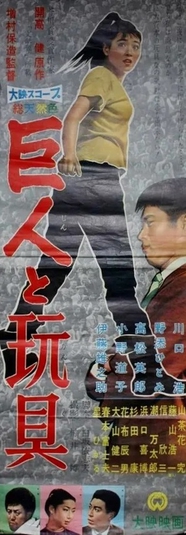Giants and Toys
| Giants and Toys | |
|---|---|
 Film poster | |
| Directed by | Yasuzo Masumura |
| Written by |
|
| Produced by |
|
| Starring | |
| Cinematography | Hiroshi Murai |
| Edited by | Tatsuji Nakashizu |
| Music by | Tetsuo Sukahara |
Production company | |
| Distributed by | Daiei |
Release date |
|
Running time | 95 minutes[1] |
| Country | Japan |
| Language | Japanese |
Giants and Toys (巨人と玩具, Kyojin to gangu) is a 1958 Japanese satirical comedy film directed by Yasuzo Masumura and starring Hiroshi Kawaguchi.[2][3]
Plot[]
Candy manufacturer World competes with companies Giant and Apollo over caramel sales. While looking for a poster girl for a new promotional campaign, chief of advertising Goda discovers Kyoko, a working class girl with bad teeth, and makes her World's mascot, dressed up in a space suit and wielding a ray gun. Meanwhile, Goda's assistant Nishi, at the instruction of his boss, has an affair with Apollo's advertising lady Kurahashi to learn about their campaign plans. As Kyoko's popularity rises to unprecedented heights, the young woman is less and less inclined to go along with World's plans for her, working on a career as a singer and dancer. After Kyoko terminates their contract, Goda, cracking up and sick from professional stress to the point of coughing up blood, wants to take over her role. Nishi, worried about his boss's health, stops him and takes over the role of the mascot himself. Dressed in Kyoko's spacesuit and wielding a ray gun, Nishi patrols the streets, followed by Kurahashi who prompts him to smile a bright smile for the passers-by.
Cast[]
- Hiroshi Kawaguchi as Yousuke Nishi
- Hitomi Nozoe as Kyoko Shima
- Yūnosuke Itō as Junji Harukawa
- Michiko Ono as Masami Kurahashi
- Kyu Sazanka as Takakura Higashi
- Kinzo Shin as Kohei
- Hideo Takamatsu as Ryuji Goda
Production[]
Giants and Toys was a short story written by Takeshi Kaikō. After Kaikō won the Akutagawa Prize in 1957 for The Naked King, Daiei Film bought the rights to Giants and Toys.[4] The story was an entry in the "business novel" (経済小説, keizai shōsetsu) genre, which satirizes Japanese workers' devotion to their corporations.[5]
Legacy[]
In the British Film Institute's list of the best Japanese films from 1925 to the present, reviewer Jasper Sharp describes Giants and Toys as a "deliciously wicked satire on the new cut-throat competitiveness of the postwar corporate world" and a "marker point of modernist cinema".[6]
References[]
- ^ Jump up to: a b "巨人と玩具 (Giants and Toys)". Kinema Junpo (in Japanese). Retrieved 31 January 2021.
- ^ "Yasuzo Masumura". kotobank (in Japanese). Retrieved 31 January 2021.
- ^ "巨人と玩具 (Giants and Toys)". Japanese Movie Database (in Japanese). Retrieved 14 June 2021.
- ^ Phillips, Alastair (2007). Japanese cinema: texts and contexts. Taylor & Francis. p. 153. ISBN 978-0-415-32847-0.
- ^ Roberts, Mark (2007). Masumura Yasuzo and the cinema of social consciousness. pp. 129–130. ISBN 978-0-549-53175-3.
- ^ "The best Japanese film of every year – from 1925 to now". British Film Institute. Retrieved 14 June 2021.
External links[]
- Giants and Toys at IMDb
- Giants and Toys at the Japanese Movie Database (in Japanese)
- Kehr, Dave (20 May 2011). "Giants and Toys". Movies. The New York Times. Archived from the original on 20 May 2011. Retrieved 14 June 2021.
Bibliography[]
- Kaikō, Takeshi (2019). 開高健短篇選 (Takeshi Kaikō Short Story Collection, containing Panic, The Naked King, Giants and Toys a.o.) (in Japanese). Tokyo: Iwanami Shoten. ISBN 978-4003122112.
- 1958 films
- Japanese-language films
- 1958 comedy films
- Japanese films
- Japanese comedy films
- Films based on short fiction
- Films directed by Yasuzo Masumura
- Daiei Film films